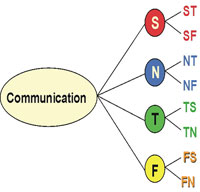Henry L. (Dick) Thompson, Ph.D.
(Type Languages, Dialects and Styles. Bulletin of Psychological Type, 20:2, 37-38.)
During APT XI in Kansas City , I was reminded of the power of type languages. In some sessions, participants were divided into dominant function subgroups to solve a problem. In one particular session, I found myself (INTJ) sitting in the dominant iNtuiting group with nine ENFPs. Needless to say, the rest of the group and I did not agree on what the actual problem was, much less how to go about solving it. The other sub-groups also had difficulty reaching consensus.
Languages
Over the years I have found that failure to reach consensus is exacerbated more by diversity of the extraverted function than of the dominant function. Grouping by dominant function doesn't work as well because it fails to consider the languages spoken by the introverted group members. Aside from the normal type differences between the INTJ and the ENFPs in the group above, there was a definite language barrier--Thinking versus iNtuiting. Language preference (1) is determined by the extraverted function, e.g., an INTJ extraverts and speaks Thinking, an ENFP extraverts and speaks iNtuiting, an ESFJ extraverts and speaks Feeling and an ESTP extraverts and speaks Sensing. Type languages are similar to foreign languages; people need to listen and speak in the same language to reduce communication problems.
Each of the 16 types can use all four languages, but with skill levels that match their preferences for sequence of use. Table 1 shows the preferred sequence for each type. Notice that both the extraverted and introverted STJs have the same language preference sequence. (2)
| Type |
Type |
1 |
2 |
3 |
4 |
| ESTP |
ISTP |
S |
T |
F |
N |
| ESFP |
ISFP |
S |
F |
T |
N |
| ENTP |
INTP |
N |
T |
F |
S |
| ENFP |
INFP |
N |
F |
T |
S |
| ESTJ |
ISTJ |
T |
S |
N |
F |
| ENTJ |
INTJ |
T |
N |
S |
F |
| ESFJ |
ISFJ |
F |
S |
N |
T |
| ENFJ |
INFJ |
F |
N |
S |
T |
Table 1
Language Preference Sequence
For two people to communicate effectively, both should use the same language. If their primary languages are different, one of them must change languages to match the other. For example, if an ESFJ (Feeling language) wants to communicate with an ESFP (Sensing language), one of them must change to their secondary language. That is, the ESFJ could change to Sensing or the ESFP could change to Feeling. They should be able to do a relatively good job of communicating--if one of them will change. If both change to their secondary (ESFJ to S and ESFP to F), they might have as much or more difficulty as before they changed.
Dialects
Within psychological Type, not only are there four languages (S, N, T & F), but also two dialects within each language. A Type dialect results from the dynamic interaction of the functional pair combination, orientation (J, P) and the language preference sequence. Unlike a language, which can be unintelligible by those who do not use it regularly, dialects can normally be interpreted by those who speak the language to which the dialect belongs.

Figure 1
Language & Dialect Breakout
An STJ with a primary language of Thinking and a secondary of Sensing speaks a different dialect of Thinking from the NTJ who has Thinking as primary and iNtuiting as secondary. Most practitioners can easily detect the differences in the dialects. (See Figure 1)
Style
At the third level of type communication, extraversion and introversion, and dominant and auxiliary interact to create a style. Although an INTJ and ENFP both have a preference for dominant iNtuiting, when they communicate they speak different languages (T vs. F), different dialects (NTJ vs. NFP) and different styles (INTJ vs. ENFP). This indicates that there is a strong probability of some communication problems between these two types (which has proven to be true). An ENFP tends to express a lot of ideas (N). The INTJ has a tendency to quickly point out why the ENFP's ideas won't work (T).
In the example of dominant function subgroups described earlier, either the ENFP's in the group or I (INTJ) needed to "change" languages to reduce communication problems. However, the secondary language for ENFP is Feeling, which is the fourth preference for INTJs,--not a very good match. My secondary language is iNtuiting, the primary of the ENFPs. I needed to change to my secondary language to match the ENFPs. This sounds easy, but consider the dynamics involved in changing languages.
Changing Languages
Switching to my secondary language of iNtuiting requires a shift not only in language, but also a shift in orientation from J to P. Because iNtuiting is a perceiving language, judging must stop in order to use it. Therefore, the switch from Thinking to iNtuiting also switches the dialect from NTJ to NTP.
The difficulty of changing from a judging language to a perceiving one is particularly evident in brainstorming sessions. One of the primary brainstorming rules is "no judging of others' ideas during the idea-generation phase." Those who have to change from a judging language (T or F) to a perceptive one (S or N) find it difficult to remain in a perceptive mode during the entire session. After all, the sometimes wacky ideas produced in a brainstorming session produce a target-rich environment for the Thinking language's criticism.
The above describes what happens to the orientation dimension when changing languages, but what about attitude? When an INTJ changes from Thinking to iNtuiting, does the attitude also change? The answer is "yes." To assist in the explication of the rationale for this, an annotated type code will be used. The dominant (D) and auxiliary (A) functions and their attitudes, extraversion (e) and introversion (i), will be designated, e.g., IN DiT AeJ.
In order to switch from the Thinking language to the iNtuiting language, an INTJ must extravert as a perceptive (P). Thus, the dialect, N DiT AeJ changes to N DeT AiP. The IN AeT DiP style extraverts the auxiliary function N Ae, supported by the dominant, introverted function T Di. The INTJs new dialect, N DeT AiP, does not match the INTP dialect, N AeT DiP; it actually changed to match the dialect of an EN DeT AiP. Observation of introverts changing from their primary to secondary language reveals a sudden "burst of extraversion." When introverts change to their secondary language, they temporarily become extraverts. The INTJ becomes an ENTP!
When extraverts change from their primary to their secondary languages, they temporarily become introverted. For example, when EN AiT DeJs change from the primary language of Thinking to the secondary of iNtuiting, they change to the IN AeT DiP style. An easy way to remember what happens when types change from primary to secondary languages is that Js become Ps, Ps become Js, extraverts become introverts and introverts become extraverts.
Summary
When working with groups or teams it helps to keep in mind that:
a. People tend to speak using their extraverted functions
b. Each language has two dialects and four styles
c. When people change languages, their "personality type" changes
d. The better you can match another person's language, dialect and style, the more effectively you should be able to communicate.
e. Because people can and do change languages, one of the key elements of the communication process is listening
Communication is a dynamic process of listening, processing and expressing information and meaning between two or more people.
References
Thompson, H. (1995). The CommunicationWheel: A Resource Book. Watkinsville , GA : High Performing Systems, Inc.
Thompson, H. (1996). Jung's Function-Attitudes Explained. Watkinsville , GA : Wormhole Publishing.
Yeakley, F. (1985). Use of the Communication Style Similarity Scales: A Cautionary Note. Journal of Psychological Type, Vol. 10, p. 40.
Yeakley, F. (1982). Communication Style Preferences and Adjustments as an Approach for Studying Effects of Similarity in Psychological Type. Research in Psychological Type, Vol. 5, pp. 30-48.
1. Thompson, 1995; Yeakley, 1982
2. I discovered in 1983 that extraverts agreed with Yeakley's sequence, but introverts did not. After some experimentation I found that introverts use the same sequence as extraverts. (See The CommunicationWheel: A Resource Book for a detailed explanation of the rationale.)
© 1997-2006 High Performing Systems, Inc.
|
